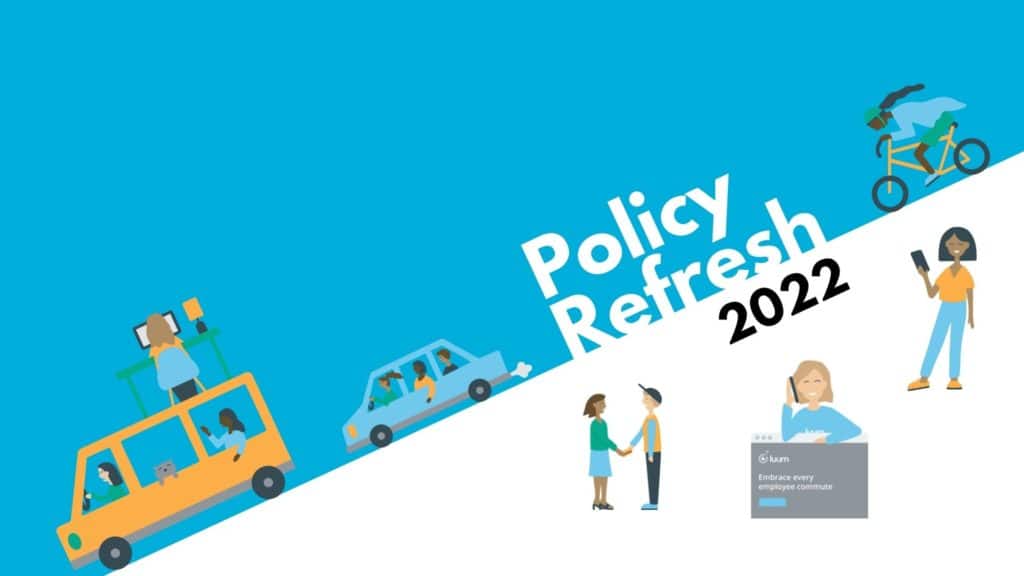Your hybrid workforce doesn’t need commuter benefits. They need mobility benefits.
Life is not the same as it once was. The workforce is continually changing, and so are employees’ needs, causing a rethink in the ways we commute. Driving to work and parking is no longer the primary method of commuting, and things like hybrid workforce mobility benefits are becoming more standard practice.
The growing adoption of hybrid work models, and a workforce that is diverse in commute experiences (from access to transportation to preferred modes of getting to work), are pushing the evolution of commuter benefits to give people more options to get to work without affecting their wallets…or their peace of mind. A simple, structured commute plan can be a major factor in a positive, world-class employee experience.
We’re here to show you how to incentivize employees and attract new talent by evolving traditional commuter benefits into benefits that are safe, flexible, and sustainable.

How has the commute changed?
Commuting is, now more than ever, an individual experience. The workforce is diverse – in how they get to work, how far they live from work, or what time or expense the commute represents to them. Hourly wage or shift workers experience a commute very differently corporate employees who visit the office two days a week, which is why we believe in commute equity. Access to transportation given the time of day or income shouldn’t be overlooked. Traditional commuter benefits—whether it’s a monthly election you set and forget, or a monthly parking pass that you don’t use on an everyday basis—can’t keep up.
Does this require a rethink of traditional commuter benefits? Yes!
While companies do want to bring their workforce back to the office, they want to do so safely, sustainably, and with a lot more flexibility. This ensures that employees are happy about their return and can stay safe amid rising health concerns in 2022.
What are companies (enterprises, hospitals, and even universities) thinking about as we kick off the new year?
- The return to office has commuting looking very different since 2019. Employees now look for positions that offer commuter benefits, allowing them to work safely from home part of the time or receive financial assistance to travel to the office.
- We’re in a competitive talent market. Attracting and retaining talent is not for the lighthearted. Commuter benefits are a unique way to entice workers who are looking for more than the traditional 9-to-5 role and everyday commute. Offering attractive, practical mobility options makes your organization more salient.
- Organizations are growing, and their ability to scale benefits administration is complex. Employers must consider tax implications and governance, as well as ensure policy compliance–all while keeping things fair for the employees.
- Subsidized parking is expensive, as is parking real estate. There’s an opportunity to turn parking and other commute benefits from a cost center to a revenue center, but that requires rethinking approaches like monthly parking permits (which under-utilize your available parking space). And although parking fees are not as much of an issue with hybrid workforce models, they’re still something that employees look at when evaluating employers. Parking could steer away talent or attract it just the same with the right policies and infrastructure in place.

Rethinking Commuter Benefits as Mobility Benefits
As commuter benefits and employees’ needs have evolved, a new term has come on the scene: mobility benefits. What’s the difference between mobility benefits and commuter benefits? Traditional commuter benefits (pre-tax transit, parking, etc.) are strict and cost-negligible, whereas mobility benefits are holistic, individual, cost-effective, and perfectly aligned with your company’s infrastructure—your parking facilities, commute policy, or program blueprints, and technology mix.
Mobility benefits are the natural evolution of commuter benefits as we know them because they cater to employees’ changing needs around commuting to and from work. They also better equip organizations with the tools, technology, and policies to respond to, and solve for, major corporate priorities. These priorities include adjusting benefits in a pandemic to increasing team member engagement, measuring sustainability and ESG impact, and realizing significant cost savings on capital expenditures through better usage of real estate and facilities.
Mobility benefits give employees options, not locking them into one transportation method and incentivizing them to come to the workplace by financing the way over or reimbursing them. The benefits put people first, serving the employees above all.
These benefits are also environmentally aware, meaning that they promote the environment by empowering people with multiple transportation methods beyond the traditional car ride. Mobility benefits offer a variety of ways to get to work, such as walking, biking, carpooling, ridesharing, vanpooling, or using public transit or shuttles.

4 Ways to Improve Workforce Mobility
As the workplace has evolved, employees’ needs have as well. Here are some changes you can make to encourage agile workforce mobility:
1) Integrate with mobility apps to get the workforce to and from work, on their own terms
Enterprise mobility platforms like Luum offer integrations with well-known and loved mobility apps. An example of this is subsidized rideshare commutes. Give your people a safe, accessible rideshare option that helps them get from one location to another with ease—with the entire commute starting and ending in your benefits platform.
You can also reimburse employees for rideshare by giving them a certain spending amount (which they can put toward other transportation methods if they so choose). We recommend setting up commuter subsidies that cover parking, transit passes, carpooling, ride-hailing, and e-bikes for starters, as well as pre-tax commuter cards for parking and transit.
2) Consider gaps in first and last mile transit for employees who are taking public transit.
We’re all for sustainable commute modes! But options like public transit can pose a problem for employees commuting late at night, or who lack access to a public transit line that will take them all the way to their worksite.
Instead, we suggest providing a variety of transportation methods that meet flexible employee schedules and allow people to commute from their phones within a matter of minutes. This ensures more sustainable commutes all around that are also accessible and affordable.
3) Meet employees where they are: Address commute needs those with limited transportation/transit options.
It’s important to ensure DEI (diversity, equity, and inclusion) in the workplace in everything you do, including empowering your team with commute equity. Not every employee has access to reliable transportation or a vehicle to drive to work. They may not have the funds to pay for monthly parking or rideshare.
Providing mobility benefits gives your team more options to return to the office, encouraging them to show up to work on time and deliver their best work every day, knowing that their employer has invested in them (and in ways to make their life and commute easier).
Mobility benefits are also inclusive, helping the entire team feel like they are included. They’re accessible to everyone, from the CEO to the frontline worker. Everyone is included. Everyone is covered. Everyone benefits.
4) Gain a holistic view into commute behavior.
Integrated platforms, such as Luum, help make the return to office commute strategy more straightforward and provide a look into your employees’ commute behavior. This helps you to identify new ways to incentivize your team or educate them on how they can modify their commute to make it better for themselves and the environment. They’re able to support integrations with enterprise mobility apps like Lyft that unify the commute and deliver better employee experiences.
Our commute management platform is an innovative tool that evolves with your company and aligns with the hybrid workforce model. It helps you manage administration, parking, and mobility choices, providing the tools and data insights you need to create a good commute program for your team while understanding tax implications.
Policy and programs
In addition to having the right technology in place, it’s imperative to implement commute policies that accommodate the future of the workforce. Take parking, for example. Some approaches to lower the demand for parking include keeping tabs on parking data, shifting from monthly permits to daily parking reservations, and incentivizing employees to commute to work using more sustainable methods than driving their own vehicles.
We also recommend that your policy covers:
- Subsidies and reimbursements
- Shuttle reservations and tracking
- Closed-network carpool matching
- A safe, guaranteed ride home
- And more
…And you can do it all through Luum. (Check out a few more of our customers’ commute policies here.)
The road ahead
Employees aren’t commuting the way they once were. Many expect a hybrid work model and the means to get to and from the office without using their own money or resources. Others need accessible, affordable transportation options that get them to work safely on their own terms. If you want to improve workforce mobility and help your employees get to the job, encourage them to commute with confidence by subsidizing parking or transit through pre-tax elections and/or employer-provided subsidies.
Mobility benefits are the solution. They provide unique incentives to attract potential team members and keep the ones you have happy. With mobility benefits, you can create workforce mobility that benefits everyone on the team.
All it takes is a plan, and we can help. If you have questions about how to unlock the potential to commute every day with confidence, we have answers! You can explore see how other organizations are adapting their commute programs, or chat with one of our commute experts.
More In the Luumlight
HR Dive: Enterprise employers navigate the hybrid commute
Our annual virtual conference, Luuminary22, was held on July 20th. We gathered a wonderful group of leaders to discuss the hottest topics of 2022: including…
Your hybrid workforce doesn’t need commuter benefits. They need mobility benefits.
Life is not the same as it once was. The workforce is continually changing, and so are employees’ needs, causing a rethink in the ways…
Return to Better: Commuter Benefit Policies For 2022 and Beyond
Daily flexibility and choice will keep your commuters safe, happy, and productive. Whether your workforce has been commuting throughout the pandemic or returning to office…



